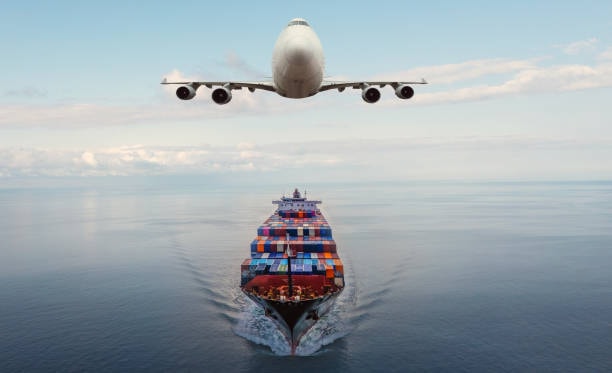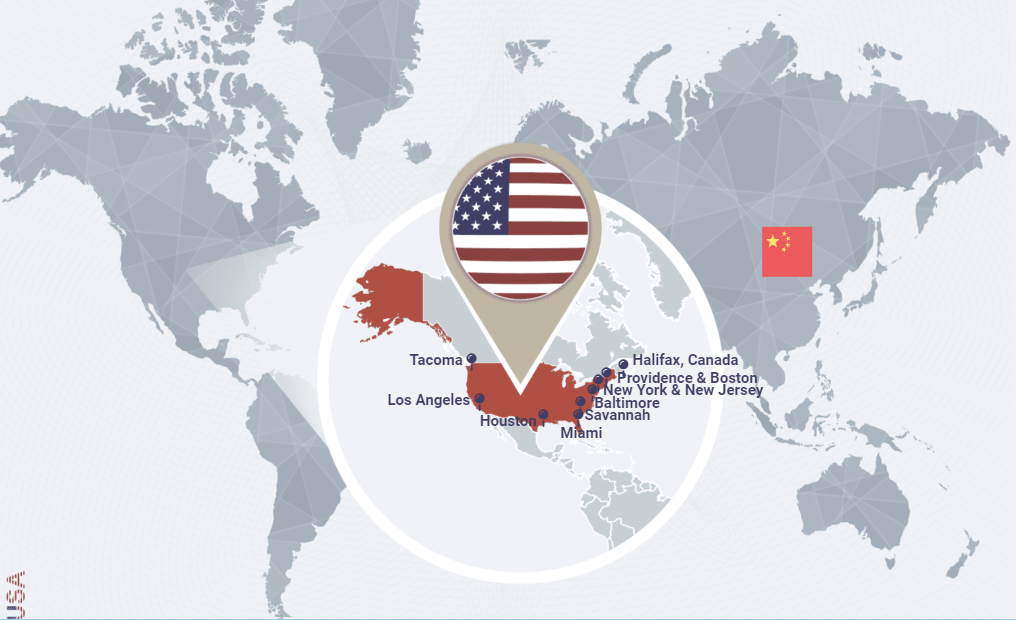Introduction
Ocean freight plays a pivotal role in global trade by moving goods across oceans and seas. At Red Flag Freight Forwarding, we offer a comprehensive suite of sea freight services designed to meet the diverse needs of importers. Our goal is to ensure that your cargo is transported safely, efficiently and on time, allowing you to focus on your core business operations. Our extensive logistics coverage spans hundreds of cities and major sea ports in China, including Shenzhen, Guangzhou, Hong Kong, Xiamen, Ningbo, Shanghai, Qingdao and Tianjin. This network enables us to facilitate shipments to destinations worldwide. Through strong partnerships with reputable vessel operators, we provide cost‑effective solutions without compromising on service quality.Contact Us
What Is Ocean Freight?
Ocean freight—also called sea freight—refers to transporting goods via cargo ships across oceans and seas. It is a cornerstone of international trade, allowing businesses to import and export products on a global scale. This mode of transport is especially popular for bulk shipments because it is more economical than air freight. The process typically includes booking the shipment, loading cargo onto a vessel, sailing to the destination port, unloading and clearing customs. Working with a reliable freight forwarder ensures your goods are shipped safely and efficiently.
Advantages of Choosing Ocean Freight from China
- Cost‑effectiveness: Sea freight is usually cheaper than air freight, particularly for large shipments.
- Large shipment capacity: Cargo ships can accommodate vast amounts of goods, making them ideal for transporting everything from raw materials to finished products.
- Environmental sustainability: Shipping by sea has a lower carbon footprint than air transport, offering a greener option for businesses.
- Flexible shipping options: A variety of services and schedules allows businesses to optimize their supply chains and inventory.
- Global reach: Ocean freight provides access to markets around the world, enabling companies to source products and materials from China, a leading manufacturing hub.
- Safety and reliability: Modern vessels and technology ensure safe transport and dependable delivery schedules.
Main Shipping Ports in China
China’s extensive coastline is home to numerous ports that facilitate international trade. Key ports include:
| Port | Location | Key features |
|---|---|---|
| Shanghai | Shanghai | The world’s busiest container port, offering comprehensive logistics services and connections to many destinations. |
| Shenzhen | Shenzhen | Proximity to Hong Kong makes this port a major hub for electronics and textiles, with advanced terminals and efficient customs clearance. |
| Ningbo‑Zhoushan | Ningbo | Rapidly growing port with deep‑water facilities capable of handling large container ships. |
| Guangzhou | Guangzhou | A historic port serving as a key gateway for goods in southern China. |
| Qingdao | Qingdao | Strategically located in northern China, important for agricultural and industrial products. |
| Tianjin | Tianjin | Main port for Beijing with extensive container and bulk cargo facilities. |
| Xiamen | Xiamen | Important for trade with Southeast Asia, known for handling perishable goods and electronics efficiently. |
| Dalian | Dalian | Northeastern port with an ice‑free harbor, vital for trade with Russia and Japan. |
Understanding these ports and their capabilities helps optimize shipping logistics and reduce transit times.
The Process of Shipping Goods by Ocean Freight
Shipping goods by sea involves a series of steps that ensure smooth transport from origin to destination:
- Choose a reliable freight forwarder: Select a reputable partner like Red Flag Freight Forwarding to guide you through the process.
- Get a quote: Request a shipping quote based on cargo specifications (weight, dimensions, destination) to plan your budget.
- Book your shipment: Provide detailed cargo information and schedule the loading date.
- Prepare your cargo: Ensure proper packaging and labeling to prevent damage and comply with shipping standards.
- Documentation: Prepare required documents such as Bill of Lading, commercial invoice, packing list and permits.
- Loading the cargo: Transport your goods to the port and load them onto the vessel.
- Customs clearance: Submit documents and pay tariffs or duties before departure.
- Transit: Track your shipment during its journey to stay informed.
- Unloading at destination: Goods are unloaded at the destination port.
- Final customs clearance: Clear customs at the destination, which may involve further documentation.
- Delivery to final destination: Arrange transportation to deliver your cargo to its final destination.
Following this process helps mitigate risks and ensures goods are shipped safely and efficiently.
Customs Clearance and Documentation
Proper documentation is essential for smooth customs clearance. Key documents include:
- Bill of Lading (B/L): A receipt and contract between shipper and carrier, detailing shipment information.
- Commercial Invoice: Describes the transaction value, payment terms and goods description.
- Packing List: Lists cargo details such as dimensions, weight and packaging type.
- Import/Export Permits: Required for certain regulated items.
- Certificate of Origin: Certifies where goods were manufactured.
- Customs Declaration: Includes classification, value and origin information, submitted to customs authorities.
Navigating customs can be complex, so partnering with an experienced forwarder ensures compliance with regulations.
Types of Sea Freight Services
Different sea freight options cater to various shipment sizes and cargo types:
- FCL (Full Container Load): A single shipper occupies an entire container. Ideal for large volumes; provides fewer handling risks and predictable transit times.
- LCL (Less than Container Load): Multiple shippers share a container. Cost‑effective for smaller shipments but may involve longer transit times due to consolidation.
- RORO (Roll‑on/Roll‑off): Designed for wheeled cargo like vehicles and machinery, where vehicles are driven on and off the ship.
- Breakbulk: Cargo that must be loaded individually, suitable for oversized or irregularly shaped items.
- OOG (Out of Gauge): For cargo exceeding standard container dimensions, requiring specialized equipment and handling.
- Consolidated Freight: Combining smaller shipments from multiple customers into one larger shipment to reduce costs and improve efficiency.
Shipping Routes from China
China’s strategic location and well‑developed ports support numerous shipping routes. Major routes include:
- China to North America (United States, Canada) via Shanghai, Shenzhen, Ningbo, Qingdao.
- China to Europe via Shanghai, Shenzhen, Hamburg and Rotterdam.
- China to Asia (Southeast Asia, Japan, South Korea) via Shanghai, Hong Kong, Xiamen, Guangzhou.
- China to Africa via Shanghai, Shenzhen, Ningbo, Guangzhou.
- China to Latin America via Shanghai, Shenzhen, Los Angeles and Santos.
- China to the Middle East via Shanghai, Ningbo, Tianjin and Xiamen.
Understanding these routes helps businesses choose the most suitable option based on shipment size, urgency and budget.
Ocean Freight Transit Time from China
Transit time refers to how long it takes for goods to travel from China to their final destination by sea. Depending on the route and various factors, average transit times range from 7 to 40 days. Typical estimates include:
- China to North America: 15‑30 days.
- China to Europe: 25‑40 days.
- China to Southeast Asia: 7‑14 days.
- China to Australia: 20‑30 days.
- China to Africa: 20‑35 days.
Factors like weather, port congestion and customs clearance may affect these times.
Factors Influencing Ocean Freight Rates from China
The cost of ocean freight can vary widely due to many factors. Key considerations include:
- Shipping route and distance: Longer routes cost more due to fuel consumption and transit time.
- Seasonality: Costs fluctuate with demand; peak seasons often have higher rates.
- Type and size of container: Standard vs. refrigerated, and 20‑ft vs. 40‑ft containers affect pricing.
- Cargo type: Hazardous or special goods may incur additional fees.
- Fuel costs: Rising fuel prices lead to higher shipping charges.
- Currency exchange rates: Changes in exchange rates can impact costs.
- Port fees and terminal charges: Loading, unloading and storage fees vary by port.
- Demand and supply dynamics: High demand with limited capacity drives rates up.
- Insurance and documentation: Insurance costs and duties add to overall expenses.
- Geopolitical factors: Political instability, trade policies and tariffs can affect routes and costs.
Understanding these factors helps businesses anticipate costs and plan their shipping strategies.
Choosing the Right Ocean Freight Forwarder
Selecting a reliable freight forwarder is crucial for seamless shipping. Important considerations include:
- Experience and expertise: Look for providers with a proven track record and knowledge of relevant markets.
- Network and relationships: Strong partnerships with carriers and ports lead to better rates and priority service.
- Comprehensive services: Choose a forwarder offering customs clearance, insurance, warehousing and tracking.
- Transparent pricing: Ensure clear pricing without hidden fees.
- Customer support: Responsive support is essential throughout the shipping process.
- Technology and tracking: Real‑time tracking and updates provide visibility and control.
- Compliance and documentation: A good forwarder understands shipping regulations and documentation requirements.
Why Choose Red Flag Freight Forwarding
As a trusted ocean freight forwarder based in China, Red Flag Freight Forwarding offers a full suite of sea freight services to meet diverse business needs. We provide Full Container Load (FCL) and Less than Container Load (LCL) options, handle customs clearance and offer cargo tracking, insurance and warehousing. Our experienced team coordinates each shipment from quote to final delivery, leveraging our global network to secure competitive rates and reliable transit. With our commitment to professionalism, cost‑effectiveness and high‑quality service, we help you navigate international shipping with confidence. For a personalized quote or consultation, please contact us at support@globalfreightagent.com.




